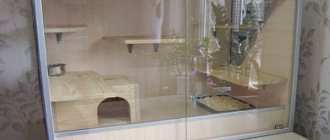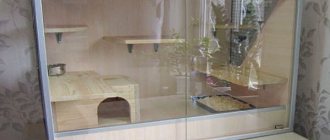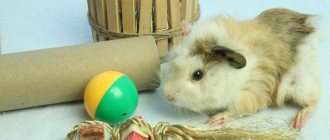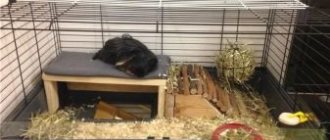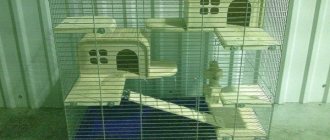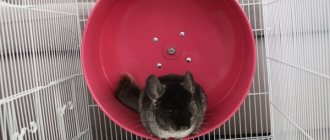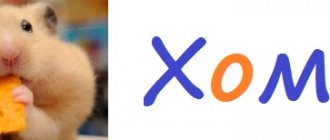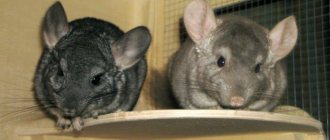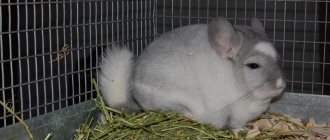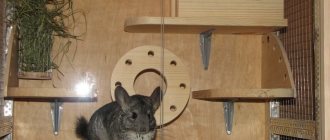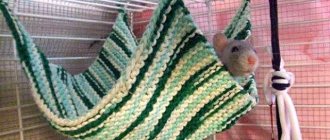Buying a chinchilla as a pet also involves purchasing various accessories for the animal. In order for him to be comfortable 24 hours a day, even when the owners are away from home or sleeping, the enclosure should have a convenient drinking bowl and bowl, as well as a hay box for the chinchilla. When it comes to the hay barn, novice owners always ask a lot of questions: what is the point of it, is it possible to arrange it yourself if the pet store doesn’t have anything suitable in terms of type and price.
What are the hay and feeders for?
The list of accessories includes more than a dozen, among which haymakers and feeders come to the fore. Despite the fact that the rodent eats very little, special dishes for food must be installed.
Considering that most food spoils quickly, it is important to select a bowl of the right size so that the animal has time to eat a portion without leaving the leftovers to rot.
Sennitsa is a type of feeder with a narrow specialization. It contains hay that chinchillas need every day to normalize digestion processes. The separation of hay as a separate accessory is due to the fact that the animal is capable of defecating throughout the cage, touching valuable dry grass.
Sennitsa in the form of a hanging ball is dangerous for chinchillas
Useful properties of meat
It has long been known that not only chinchilla fur is of great value.
Some farmers prefer to raise individuals only for the purpose of obtaining meat products. These animals have tender, low-calorie meat, which is in demand among connoisseurs, as well as people with certain diseases. Chinchilla meat is consumed by patients with sclerosis of various forms, as well as to relieve the symptoms of tuberculosis. This dietary product is in high demand among people with cancer, because rodent meat has healing properties, and the components included in its composition prevent the active development of tumors.
Only healthy adults are used for meat
Sennitsa for chinchilla: varieties
A high-quality chinchilla hay feeder must meet the following criteria:
- safety for the animal;
- holding an armful of hay inside;
- the ability for the chinchilla to freely get the required amount of grass;
- no chance of urine getting on valuable food.
Manufacturers of pet supplies produce several types of hay feeders: internal and external, metal and plastic.
Experts definitely do not recommend buying:
- plastic products - they are quickly chewed by animals;
- hanging wire balls - the animal can stick its head inside and get stuck.
Opinions are divided regarding the location inside or outside. Some experts prefer the first option due to the preservation of cleanliness.
The following factors speak in favor of external ones:
- saving additional space in the cage;
- complete safety for the animal;
- dried grass does not crumble.
Features and specificity of green food for chinchillas.
| Green food | Special properties |
| Nettle |
|
| Dill |
|
| Flowers Daisy |
|
| Shepherd's Purse | |
| Lovage |
|
| Alfalfa |
|
| Milk Thistle Herb |
|
| Oregano | |
| Peppermint leaves |
|
| Calendula flowers | |
| Plantain |
|
| Spinach |
|
| Head lettuce | |
| Endive, or Salad chicory |
|
| You can't feed these herbs |
|
| Cucumbers (all types of cucumbers are suitable for feeding) |
|
| These plants can be given, but in minimal quantities and very rarely. |
|
| Apples |
|
| Strawberry |
|
| Rose hip |
|
| The following fruits should not be given |
|
| Apple tree branches | |
| Alder branches | |
| Don't give the following branches |
|
You may like: What do meerkats eat?
When feeding chinchillas, use the principle that less is more. Adding new food to the diet should be done gradually; new food should be mixed with old food.
Feeder for chinchillas: what are they?
The choice of feeders in the pet store is large, so before purchasing you should familiarize yourself with the parameters that the ideal solution meets:
- material. Plastic is excluded, it will be eaten along with the food in a short time. Experts advise choosing metal bowls, although you can consider glass or ceramic;
- form. It is important to purchase a stable container that can be placed on the floor. The chinchilla will remove the hanging structure from the bars and scatter pieces of food throughout the cage;
- fastening. The feeder must be firmly attached to the cage - rodents love to play with containers, turning them over.
A ceramic feeder can be original.
An automatic feeder will cost a little more, but solves many problems:
- simply integrated into the cell;
- doses the amount of feed;
- a rodent cannot use it instead of a toilet;
- the ingress of debris is virtually eliminated;
- in this case, cleaning the cage is simplified.
Toys from improvised means
Inventing and making toys for small rodents at home is not only useful, but also exciting.
In addition, making accessories yourself significantly saves the family budget. Most often guinea pigs are offered:
- improvised grinding stones that are hung just above the floor of the cage - the animals first play with them, and then happily gnaw on them and grind down their incisors;
- old wooden cubes;
- soft toys - as a rule, rodents first sniff them, then take them to their house; a disheveled toy must be promptly replaced with a new one;
- Tennis or ping-pong balls are one of the most favorite toys of guinea pigs - they push the balls with their paws, head, and roll them around the cage;
- tubes from large paper napkins;
- wire (or twine) with treats strung on it.
How to make a hay box for a chinchilla with your own hands
For experienced and skilled owners, a do-it-yourself chinchilla hay rack is preferable. To do this, you need:
- Saw and sand the boards for the side walls, bottom, and back wall. The latter can be made more elegant by cutting out a semicircle.
- Make a slot in the side walls to attach the grille.
- Connect all the walls.
- Secure the grille.
- Sand again, rounding all corners.
Finally, you need to attach the hay box under the shelf in such a way that it is easy to replenish the hay, and a rodent cannot climb into the device.
Drinking bowl
A drinking bowl for a chinchilla must meet certain requirements: be closed, have enough volume, and be securely fastened. The most successful option are automatic drinkers or nipple-type drinkers. They allow you to keep water clean and fresh for several days.
Making a drinking bowl at home
You can make a drinking bowl for a rodent with your own hands from a bottle of saline solution. In addition to the bottle, you need to have a pipette tube and a small piece of wire. Manufacturing begins by removing the rubberized cap from the bottle and making a hole in it at a slight angle. The diameter of the hole should be slightly smaller than the diameter of the pipette - this way it will fit more tightly into it. Insert the pipette. The bottle is wrapped with wire and attached to the outside of the cell so that the tip of the pipette is inside the cell. It is better to fix the drinker at an acute angle - this way water will not drip to the bottom of the cage.
DIY chinchilla feeder: instructions
Making your own feeders for chinchillas will not take much time. Thoroughly washed and treated cans, heavy ceramic bowls, and glass ashtrays are suitable as bowls.
The owner only needs to securely fasten the container so that the rodent cannot turn over or move the feeder from its place. After that, it’s enough to pour in the food and enjoy the process of feeding your pet.
For interesting ideas on how to make your own house for a chinchilla and what can be used as a bathing suit from scrap materials, read the article “Homemade and purchased houses for chinchillas” and “Purchased and homemade bathing suits for chinchillas.”
Hay
Before making a hay barn for a guinea pig, you should understand what grass is needed and why.
The hay fields are filled with dry grass, which such a pet needs. It has a beneficial effect on the health and functions of the body. It is important that hay is present in your pet’s diet.
Benefits of hay for pigs
This is one of the main parts of the animal’s diet, as it is a source of fiber. Hay directly affects the health, condition of teeth and digestion of the pig. It is important to monitor the presence of this ingredient when feeding your pet. It’s especially good that you can make a hay barn for guinea pigs with your own hands.
Places to get hay
First of all, you can simply buy dried grass at a pet store, exchange or ask people raising livestock and purchase it online, or prepare it yourself, which will save some money each time you change food. To collect herbs yourself, you should choose remote places away from roads, industrial areas and livestock walking.
You need to dry the herbs in a well-ventilated room, turning them over regularly.
Hay qualities
Only good dried grass should be added to the hay box for guinea pigs so that it is easier for your pet to digest.
Factors that affect hay quality:
- Freshness;
- dryness;
- absence of dust and other particles, as well as mold;
- the presence of long stems;
- composition of several herbs;
- nice smell;
- green color.
Sennitsa for chinchilla
Buying a chinchilla as a pet also involves purchasing various accessories for the animal. In order for him to be comfortable 24 hours a day, even when the owners are away from home or sleeping, the enclosure should have a convenient drinking bowl and bowl, as well as a hay box for the chinchilla. When it comes to the hay barn, novice owners always ask a lot of questions: what is the point of it, is it possible to arrange it yourself if the pet store doesn’t have anything suitable in terms of type and price.
Accessories for guinea pigs
Most often, tunnels are made of fabric
Guinea pig tunnel
Small pets love to explore and climb artificial burrows, and in a suitable cage you can create a global system of passages.
Labyrinths and tunnels are presented in a large assortment in modern pet stores. Most often they are made of fabric, wood or plastic. You should be prepared for the fact that some materials that an animal can chew without causing harm to its health are very expensive, so the cost of such tunnels is far from budget.
The bed can be made in different shapes
Guinea pig bed
A bed in the form of a rug or mattress are items that your pet will definitely like. They differ from each other only in that the latter has sides.
The bed can be made in any shape: rectangular, square, round, and if desired, you can add fur. As soon as the animal gets tired, it will climb onto its bed, laying its head on the side, which will replace its pillow, and go to sleep.
A hammock makes your guinea pig feel sheltered
Hammock
A hammock is a great alternative to replacing an uncomfortable house that is often already added to a pet's cage. The guinea pig can lie either in the hammock itself or under it. Thanks to this accessory, the animal feels hidden, but at the same time the owner can watch his pet.
Your pet will definitely love a slide or stairs
Stairs and slides
Pets love heights. Your guinea pig will definitely love a slide or stairs. There is no need to worry about the safety of the animal, as they have very developed muscles and dexterous paws. Such pets feel confident when they climb up a slide or ladder. By the way, a ladder can be made from twigs, chopsticks or pencils, tying them together with a rope.
Important: the animal may have problems descending; to do this, you need to soften the place of the fall in order to protect it
Swing
Guinea pigs love swings. Today there are many options for such toys: plastic, wooden, metal. And in pet stores you can choose either a board on a movable rod or a swinging tube.
Walking ball for guinea pig
Walking balls, according to veterinarians, are a dangerous toy for guinea pigs. After all, the bodies of these animals do not have the necessary flexibility, so they are not suitable for running in a ball. Moreover, most likely, in such a toy the animal will simply look at the wall of the ball, since they are myopic.
Therefore, you should not throw money away, because such toys are not suitable for guinea pigs, regardless of their size. This accessory is more suitable for mice, hamsters or rats.
A harness can harm your guinea pig.
Leash and harness
Quite often in pet stores you can find various types of walking belts for guinea pigs. But they are just as dangerous as walking balls. After all, even a slight tug can cause the animal’s ribs to break. And if the animal gets scared, then it may begin to squirm in the harness or try to escape, which will also lead to unwanted damage, from broken ribs to a fractured spine. Such damage is not always noticeable the first time, since pigs usually do not show that they are in pain.
How do you walk your pig?
What is sennitsa
Hay is the main food for chinchillas. And sennitsa is a type of feeder. Eating dried herbs normalizes the functioning of the chinchillas’ digestive system and provides the animal with vitamins and microelements.
You can’t just scatter food in the cage, since the animals defecate wherever they want. And then they won’t eat food with feces. The chinchilla's hay box should be placed on a raised platform in a separate feeder - a hay box.
- safety for chinchilla;
- holding an armful of dried grass inside;
- the ability for the animal to easily get and eat a portion of hay;
- guarantee that feces do not get into the food.
Grass collection
If it is winter and there is no way to find fresh plants, ready-dried hay for pets can be purchased at pet stores or ordered online. It contains guinea pig-safe plants and is fully prepared for pet consumption.
Well, if summer is in full swing, you can collect the grass yourself, while adhering to the following rules.
- The plants that you will harvest should be located away from large cities, highways and highways.
- You should not collect weed near industrial enterprises, or in areas where livestock graze.
- Only healthy-looking plants with a bright green color should be selected. Stems and leaves should not be affected by parasites or diseases.
- Grass that has already dried out is not suitable for harvesting.
- It is advisable that the harvest include alfalfa and timothy. These herbs are rich in beneficial microelements and have a positive effect on the digestive system of rodents.
Varieties of sennitsa
The chinchilla canopy can be made in two versions:
- with external fastening to the cage;
- with internal fastening.
Both options have advantages and disadvantages, convenience and operational problems.
Safer for the animal is an external hay. It is not traumatic, does not take up space in the cage, and the hay does not crumble due to the activity of the animal.
And the best option for an internal canopy is made of stainless steel. Chinchilla lovers are very popular with chinchillas in the form of a ball made of wire. This decorates the enclosure. But the disadvantage of these models is that the animal can get its paws or nose stuck between the rods while reaching for the grass. And then, to help him free himself, you will have to make a lot of effort so as not to injure the pet.
It is not recommended to purchase plastic kennels - a chinchilla can chew it off in one day.
Peppermint treat
Ingredients:
- 1 medium overripe banana.
- 2 chicken eggs.
- 3 tbsp. spoons of honey.
- 3 tbsp. tablespoons of liquid coconut oil (can be replaced with sunflower oil in the same amount).
- 1/2 teaspoon mint flavoring.
- 1/2 teaspoon baking powder.
- A quarter cup of carob (roasted carob powder). A small amount of cocoa can be substituted, but this is not recommended for animals. Therefore, try to find an original product.
- Oat flour.
Cooking procedure.
1. Mash the banana in a bowl.
2. Beat eggs into the resulting mass, add honey, baking powder, cinnamon and coconut (sunflower) oil.
3. Add oatmeal to the mixture to form a firm but slightly moist dough.
4. Divide the resulting volume into 2 equal parts.
5. Pour 1/4 cup of carob powder into one half, and add the same amount of flour to the second half. A hard lump should form that does not stick to your hands.
6. Roll out 2 rectangles, 9-10 mm thick.
7. Place the layers of dough on top of each other and roll along the long side. Wrap the resulting sausage in plastic wrap and put it in the refrigerator overnight.
8. Preheat the oven to 180 degrees.
9. Cover a baking sheet with parchment paper.
10. Remove the film and cut into 3-3.5 cm rounds.
11. Place on a baking sheet. During cooking, portions of dough will not increase in volume, so you can place them close to each other.
12. Bake for 10-15 minutes.
If you want to please your pet with a crunchier treat, cut the rolls into thin slices (about 1 cm), and after cooking, additionally dry them in a warm oven or even in a non-stick frying pan.
The finished product is stored for a long time in a dry place. So, by baking peppermint rolls once, you can treat your four-legged pupil with them for a long time.
Bon appetit to your dog!
I like it I don't like it
How to make a hay box for a chinchilla with your own hands
You can assemble a feeder from materials available at home, which can be found in every household. No DIY skills are needed - just a couple of hours and patience.
Required tools and material:
- thin boards or sheets of plywood;
- metal grid;
- dowels (preferably with a cross-section of 6 mm);
- drill or screwdriver;
- hammer;
- sandpaper (or a drill with a special attachment).
- The board is sawn to the intended dimensions - you will need 4 boards: for the floor, side and back wall. The workpieces must be sanded.
- The mesh is cut to the size of the feeder.
- Slots are made in the blanks for the side walls to secure the mesh to the front and ceiling.
- All parts are connected to each other using dowels.
- The corners of the feeder are sanded.
Menu of a pregnant female
The diet of an animal expecting cubs does not differ significantly from the diet of others. Veterinarians insist on increasing the protein content in food. If the female begins to drink and eat much more, then this is normal. After all, another living creature is forming and developing inside it, which also needs to be fed. The main thing: the expectant mother is prohibited from overfeeding, otherwise obesity and health problems cannot be avoided. Also, the animal’s menu should be supplemented:
- sprouted grain. Reproductive function will return to normal due to the vitamin E content in complementary foods;
- food of animal origin. You'll have to go to the pet store to get it;
- calcium Once a day, a quarter of a tablet will help the expectant mother replenish the supply of this microelement, since the baby “takes” it from the female;
- apple Every day, 3 weeks before giving birth, it is worth introducing an eighth of the fruit into the diet of a pregnant animal;
- beebread. A couple of balls a day will have a beneficial effect on the health of both;
- alfalfa and strawberry leaves, flax seeds and rose hips, calendula flowers and oatmeal. They will bring the rodent's lactation to the required state.
It is important to exclude mint, thyme and lemon balm from the diet of a pregnant female.
Options for canopies made from household items
A do-it-yourself chinchilla canopy can also be made using available materials. For example, a stand for forks and spoons with large cells in the walls is suitable. It is better to take galvanized steel so that the chinchilla cannot chew it. In addition, such a hay will be quite heavy. The animal will not be able to move it from its place, and it is easy to attach it to the walls of the mesh using the holes.
Another option, if the enclosure is spacious enough, is to place a metal vase for cookies with slots as a hay box - such vases are sold in the dishware department.
Source
Instructions for choosing and creating your own feeder and kennel for a chinchilla
To provide the chinchilla with stable conditions, a feeder, drinking bowl and hay box are placed in the home.
For drinking bowls and feeders, the material of manufacture (glass, plastic, metal or ceramics) and its weight are important: this way the animal will not be able to turn objects over. It is allowed to use simple dishes if the pet store does not have suitable containers. The normal option for a drinking bowl is an automatic reservoir with a stick, which is attached to the cage: the pet licks the stick and gets water. Filling an automatic drinker with liquid is easier than a regular one.
This article will tell you what sennitsa is and what it is eaten with.
Setting up a guinea pig cage
If the pet’s home is small, then the necessary minimum of “furniture” is installed in it: a drinking bowl, a feeding trough, a hay barn, a tray, a house. Animals love space and to run around, so you shouldn’t clutter up a small space with unnecessary accessories. If the space allows you to place additional accessories and entertainment, then this will not hurt the animal. These include stairs, shelves, houses, labyrinths. It must be remembered that all these elements must be safe for the animal.
To save space, it is better to purchase drinking bowls and hay bars that are attached from the outside. There are models with retractable feeders. If the feeder is placed inside the cage, it is better to choose heavy ceramic models with a wide bottom or containers that can be attached to the grid to avoid tipping over.
It is recommended to choose a house with two openings for entry and exit to make it more comfortable for the animal. Also, for ease of cleaning, the house should be chosen without a floor. A holiday home with a flat roof will function as a shelf if a safe ramp is connected to the roof.
Proper arrangement of the cage will ensure a comfortable life for the animal, and will also allow the owner to easily restore order in the house.
Be sure to add filler to the bottom. It must be changed regularly to prevent moisture from accumulating at the bottom and to prevent the growth of unwanted bacteria.
A large number of types of housing for rodents in pet stores allows you to choose the most convenient for a particular case. If you need a completely unusual option, then you can make such a design yourself. In any case, it is necessary to proceed from the requirements of keeping a pet so that it lives a long and happy life.
What are the hay and feeders for?
The list of accessories necessary for the animal is about a dozen, the first among them being a drinking bowl and a hay box. Although the rodent eats little, special dishes must be placed in the cage.
Since some food spoils quickly, it is important to choose a bowl based on the portion that the animal eats at a time, so that the leftover food does not rot.
Sennitsa for chinchillas is a variant of a feeder with a narrow purpose. Hay is placed there, which is necessary for the daily normalization of the pet’s intestines. The classification of the hay as an accessory is due to the animal’s ability to defecate throughout the cage, including dry grass.
Mirror in a cage
Installing a mirror in a guinea pig's cage is an unmistakable technique. This item ensures that the animal does not get bored. It will become a favorite pastime for the animal. She will spend a lot of time near him, looking at her image with interest. The pet will be confident that he is communicating with another animal, and he will not feel lonely.
It is not necessary to buy a new mirror for the cage. A small old one or a cosmetic bag equipped with a mirror will do.
The only important thing is that there are no chips or sharp elements on it. The best framing options for a mirror are plastic and wood.
The mirror must be fixed well so that the animal does not have the opportunity to move it.
Sennitsa for chinchilla: varieties
A good hay feeder meets the following parameters:
- safety for chinchilla;
- keeping hay inside;
- the ability to get the right amount of grass;
- preventing urine and excrement from getting onto the feed.
Manufacturers produce several types of hayrides: external (external) and internal, plastic and metal.
Experts definitely do not recommend buying:
- plastic accessories: animals quickly chew them off;
- wire hanging balls: a chinchilla can stick its head inside and get stuck.
Opinions are controversial regarding the external or internal location of the sennitsa. Some prefer option No. 2, as it preserves cleanliness, others prefer option No. 1. Factors in favor of the latter:
- saving extra space in the cage;
- absolute safety for the pet;
- hay and grass are not scattered.
Feeder for chinchillas: what are they?
A wide range of feeders requires you to familiarize yourself with the standards that the ideal choice meets before purchasing:
- Material. Edible plastic is excluded as it will not last long. Experts recommend choosing bowls made of metal, ceramics or glass.
- Form. A stable container firmly placed on the floor will do. A hanging feeder will be quickly removed from the bars by the chinchilla, and the food will be scattered throughout the cage.
- Fastening. The item must be securely attached to the cage, since rodents often turn over containers.
An automatic chinchilla feeder is more expensive, but solves several problems at once:
- Easily integrated into the cage.
- Determines the feed rate;
- Cannot be used as a toilet;
- Does not involve debris.
- Makes cleaning easier.
Popular types
There are several types of feeders, but the most common are external and internal hay feeders. Let's look at each of them.
External hay mangers should be attached to the part of the cage in which the feed tray is planned to be placed. The feeder is usually represented by a box, a bottom and three wooden or metal walls. To make the fourth wall, a coarse mesh is used. The cover can be attached using hinges. Sometimes there are completely open structures. The choice of type of structure depends on where the nursery is located - indoors or outdoors. If a drinking bowl is adjacent to the cage, then the feeder is located on the other side.
Domestic
If the design of the cage does not allow connecting the feeder from the outside, an internal hay rack comes to the rescue.
How to make a hay box for a chinchilla with your own hands
For experienced owners, home-made hay boxes are preferable. They can be made from tools found in every home. The undertaking does not require knowledge or skills: a few hours and a little patience are enough.
To make a hay barn with your own hands, you need to select tools and materials:
- plywood or boards;
- metal grate;
- dowels for furniture (6 mm);
- drill or screwdriver;
- jigsaw;
- grinding device (drill/grinder with attachment, sandpaper) and hammer.
To begin with, prepare a furniture panel or boards. Saw into pieces of the required size:
- side walls – 10×13 cm;
- back wall – 18×11 cm;
- bottom board – 10×14.2 cm.
The resulting 4 boards are drilled with a diameter of 5 mm. This is necessary to drive the dowels in with a hammer. Additionally, notches are made on the side boards to secure the hay bar in the lattice.
Next, all parts are connected using dowels. Sandpaper is used to remove rough surfaces.
Important: the device should provide easy access to the food and eliminate the chance of a chinchilla getting into it. She will be able to get food without scattering it around the area, and the grass will not fall out of the hay.
Vintage basket
Here we are dealing with a representative design in the style of modern rural fashion. Best suited for lovers of cycling or short distance travel on scooters. The basket itself is woven from flexible willow and equipped with an openwork wire lid, which prevents the cat from wanting to get out while moving. At the first glance at such a carrier, one is reminded of idyllic pictures from centuries ago, when food from the market was transported in a similar way on bicycles. The entire structure is conveniently attached to the steering wheel using leather straps and does not require much time for preparation.
The advantage of the option under consideration is, of course, its original design and originality. The downside is limited functionality. Although, if desired, the basket can be used for its intended purpose.
Price – 1,128 – 1,708 rubles.
The simplest option for making a chinchilla haybox
As an accessory, you can use an ordinary stand for kitchen tools, sold in the store. A stand made of galvanized steel is ideal: the animal will not be able to chew it.
The stable and heavy object has several sections, small legs, and a fine mesh at the bottom. Fixing the device between the bars of the grille will not be difficult, and its appearance will delight connoisseurs of beauty.
You should consider the purchase wisely, ensuring comfort and security for your pet.
Physiological characteristics of the chinchilla body
Well, after we delved a little deeper into the psychology of the relationship between these rodents and learned how to introduce them correctly, it’s time to answer the question of when you should start expecting offspring from a female chinchilla and a male. Thus, male chinchillas reach sexual maturity at 7-9 months, while females “mature” earlier and can mate at 6-8 months. However, as you understand, reaching sexual maturity does not mean that the rodent’s body is physically stronger and can withstand such a load, especially for females, such as giving birth and feeding small cubs. Therefore, it is still better not to mate animals before 1 year. The main thing is that the animals develop fully physically, eat well, then you will still have time to enjoy the long-awaited offspring. By the way, if the weight of a female chinchilla is less than 500 grams, it is not yet recommended for her to give birth.
The female's sexual cycle lasts 30-50 days, and the estrus itself can last from 2 to 4 days. In other words, every 40 days (on average), a female chinchilla is ready for mating within 2-4 days. By the way, it is not at all difficult to distinguish a female from a male. In the female, her genitals are located close to the anus, but in the male there is a gap between them and the anus where the testes are located, which are hidden under the peritoneum.
How to tell if a female is ready to mate
In addition, it is recommended that chinchilla owners keep a calendar in which they will mark the beginning of the hunt and its approximate completion - in the future, this will help to most accurately calculate the approximate date of birth of the offspring, and the start date of the next hunt. Also, her behavior will help you find out that the female is physically and psychologically ready for the mating process. The chinchilla begins to behave more active than before; it may refuse food and even scatter it around the cage. The female's genitals increase in size and become pink.
DIY chinchilla feeder: instructions
Making a feeder with your own hands is a quick job. This is available from the funds available on the farm. The undertaking does not require any knowledge or skills: a few hours and a little attention are enough.
Washed and disinfected cans, heavy ceramic bowls, and glass ashtrays are suitable for bowls.
The owner must firmly secure the container so that the pet cannot move or knock over the bowl. Then just put the food in and enjoy the spectacle of your pet’s meal.
For excellent thoughts on how to make your own house for a chinchilla, and the materials for making the bathtub, read the articles “Homemade and purchased houses for chinchillas” and “Purchased and homemade bathing baths for chinchillas.”
Source
Feed and water
When keeping chinchillas at home, their diet must include 2 types of food:
- Dry ready-made food. Friable or granular.
- Hay
- Some goodies
Regular crumbly or granular
Chinchillas are great at eating any type of food. As already written above, there are 2 types of food, the usual one consists of components in their usual form, and in the granulated form they are compressed into one granule.
Regular food costs only 100 rubles per 500 gram package. Its only drawback is that the chinchilla often chooses the most delicious ingredients, and discards some of them. This may result in a lack of microelements or vitamins.
Granulated food costs about 300-500 rubles. for 500 grams. It solves the main problems.
- The chinchilla eats the granules completely, which means it will receive all the necessary vitamins and microelements
- Pelleted feeds have a richer composition and many types of grasses. Chinchillas feel much better when they consume it and get sick less often.
- Vitamin premixes thoroughly solve problems of vitamin deficiency.
If there is a problem with the availability of granulated food in your city or it is too expensive, then make it yourself. It’s quite easy to make, the main thing is to purchase all the ingredients.
Treats for a chinchilla are a holiday. When you give treats to your animal, he immediately sees how grateful he is to you. With the help of treats, the taming process becomes faster, the animal gets used to you faster. For chinchillas, fresh fruits and vegetables, dried fruits and vegetables, seeds, nuts, dried fruits, etc. are treats.
Before giving treats to chinchillas, read this article. Some treats are very dangerous for their weak digestion, while others need to be given in limited quantities.
And clean water, never from the tap. Best to use:
- Clean, spring water. Contains many useful microelements.
- Bottled. The water is safe, but due to good purification it is practically devoid of all microelements, so the rest of the diet should be rich in them.
- Passed through a filter. This water is more harmless than tap water.
